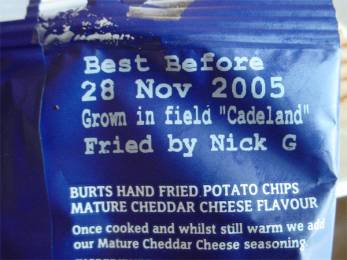
Food & drink
Virtual vineyards
It is predicted that within five years 20% of Australian wine will be made by companies that do not own vineyards or wineries - companies will either sell and lease back vines and production facilities or they'll simply purchase what they need on the open market. This sounds a bit crazy, especially when you consider trends like localisation and authenticity but similar cost-cutting tactics been used in other industries for years. In the future perhaps all companies will operate like this: no full time employees, no factories, no offices, no stock or any other physical assets. They'll own nothing except intellectual property and contracts. One suspects that in the long term this might also mean they won't own customer trust or employee loyalty either. Maybe this is an opportunity for smaller wineries to stress where their wine is from, who made it and when.
Ref: Sydney Morning Herald (Aus), 2 November 2004. Wineries are virtual, tactics are real. http://www.smh.com.au
Culinary trend mapping
What's next in the food world? According to a smorgasbord of experts the answer includes smoked foods, slow roasted foods, seared foods, regional foods, artisan foods, comfort foods, mayo, coconut, juices, botanicals, noodles, toast and 'small plate' meals. If you're wondering what trend mapping is it's basically a framework for identifying what's hot and what's not. The process involves a number of observations and predictions from chefs and other culinary experts. Trends are mapped according to where they've been seen, the level of media coverage and whether the ideas have the right ingredients to become a mainstream success. The trick, as usual, is timing. Adopt an idea too quickly and you'll have nothing but a niche market. Move too slowly and you'll miss the gravy train altogether. Of course it could all prove to be a flash in the pan.
Ref: http://www.nowandnext.com (future of food presentation) See also Culinary Trend Mapping Report, summer 2004; A Quarterly Journal of Food and Ingredient Insight (US).
Packaging innovations
Here are two interesting new ideas. Hort research in New Zealand has invented what's called the RipeSense sensor, which detects whether fruit is ripe from inside plastic packaging. The sensor works by analysing the smells given off by fruit and then changes the colour of the packaging to tell customers whether fruit is crisp, firm or juicy. Over in Spain the Mar De Frades winery has created a bottle of wine that tells you when it's ready to drink. The label is printed with temperature sensitive ink, but instead of simply changing colour when the bottle reaches the perfect temperature, a small ship appears on some waves on the label. Why can't someone invent a pack that changes colour when products pass their use by date?
Ref: Time (US) 29 November 2004. http://www.time.com
Is Atkins dead?
It was once the hottest trend in town but it looks increasingly like low-carb is no longer flavour of the month - in the US at least. In 2003 a staggering 3,737 new low-carb products were launched in the US according to ProductScan Online and every major food company was busy re-engineering its product portfolio to take advantage of the phenomenon. AC Neilsen Label Trends reports that sales of low-carb products grew by just 6% in the quarter to 25 September 2004 compared to double-digit and treble-digit growth in late 2003 and early 2004. Why the fall? With hindsight it looks increasingly like just another diet craze (remember the oatmeal fad in the late eighties?) but it's also linked to various studies and reports claiming that a low-carb lifestyle is actually bad for your health.
Ref: Is the low-carb boom over? M. Warner, The New York Times (US) 5 December 2004. http://www.nytimes.com
Take your time and sleep on it
The Scientific American reports that people who get less than five hours sleep a night have 16% less leptin and 15% more ghrelin in their bodies than people who get a good rest. Leptin depresses appetite while ghrelin increases it. This is an interesting finding because in the US people now sleep for an average of 6.9 hours compared to 9.0 hours in 1910, so perhaps the increase in working hours and the subsequent lack of sleep is contributing to obesity. On a related note a number of people have recently commented on the so-called 'French Paradox' - the strange situation where people in France eat what is a seemingly unhealthy diet, yet live long and healthy lives. One explanation for this is societal pressure to look thin but another explanation is simply the fact that the French take their food seriously. French meals are generally eaten whilst sitting at a table and food is eaten relatively slowly. It's all food for future thought.
Ref: The Australian (Aus) 11-12 December 2004. http://www.theaustralian.com. See also French Women Don't Get Fat by Mireille Guiliano.
